Southern Kentucky Granite: Planning for the Future
Peter Marcucci
Photos Courtesy Southern Kentucky Granite
 |
|
Above: The Southern Kentucky Granite showroom is all about educating the customer. All slabs are priced per-foot, and generically priced out as a 45-square-foot kitchen for easy comparison. |
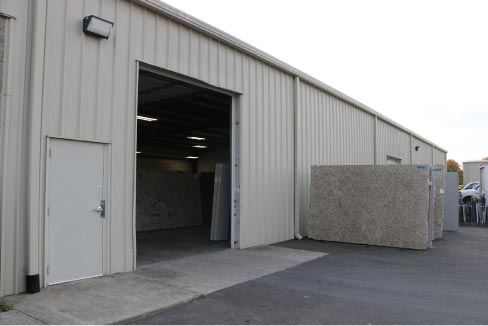 |
|
Above: Southern Kentucky Granite shop and slab storage yard. |
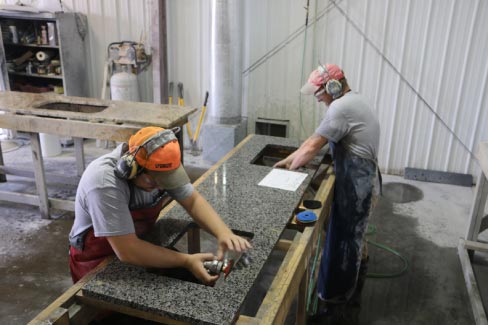 |
|
Above: Four full-time fabricators and three dedicated installers form the backbone of Southern Kentucky Granite’s production line. |
 |
|
Above: Add in a Donatoni Sawjet 625 CNC bridge saw and an Intermac Master 38.3 CNC Router and they are prepared for any job that comes along. |
 |
|
Above: The Tomahawk Stone Splitter from Braxton-Bragg helps Southern Kentucky Granite produce material for backsplashes, fire pits and more. |
 |
|
Above: Any waste stone larger than six inches in width is recycled and used as a resource to generate additional revenue. Says owner Eric Aldridge,“I’ve taken material that was going into the trash and created something that has value.” |
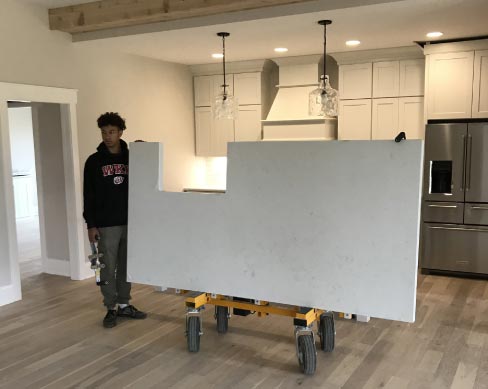 |
|
Above: Southern Kentucky Granite’s newest equipment purchase is the No Lift Install System, which can effectively reduce the number of installers needed to safely bring in and set up heavy countertops. |
 |
|
Above: An Intermac Master 38.3 CNC Router handles all their wet milling, routing and bowl cutouts – tasks that used to generate the most dust in the shop are now largely more automated. There’s plenty of finishing work done by hand, though. |
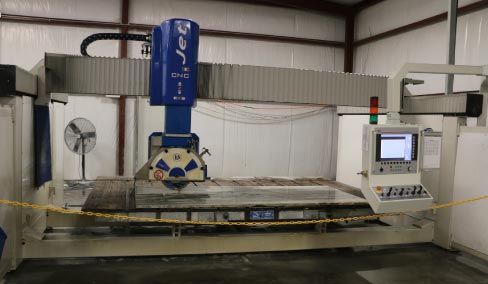 |
|
Above: Donatoni Sawjet 625 CNC Bridge Saw has helped them take production digital and dust-free. “Templates can now be e-mailed to the shop, and we can sometimes have the job completely cut out before the template man gets back at the end of the day,” said Aldridge. |
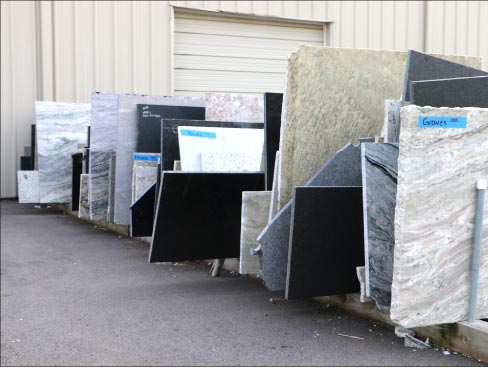 |
|
Above: Successfully tracking and riding herd on their remnants allows the shop to reuse them for vanities and keep the shop more profitable. |
 |
|
Paying attention to hand-finishing details like rolled edges helps Southern Kentucky Granite maintain a high standard of quality. According to Aldridge, granite is still the big seller, but sales of engineered stone have picked up dramatically over the last few years. |
 |
Eric Aldridge started Southern Kentucky Granite in a 30-by-30 -foot building. He fondly recalls he opened the doors with three employees: me, myself, and I, dry cutting with a Blue Ripper hand saw, and shaping and polishing with the most basic tools.
Eric may have worn many hats in those days, but it didn’t slow him down for long.
Eric was used to working his way up while picking and choosing directions, operating using the skills he’d learned in the cabinet industry.
“I started selling cabinets and granite countertops at the age of 16 in 1990, and by 2004 had added residential contracting to my services. It was these two businesses that were the catalyst to open Southern Kentucky Granite in 2010, after a fabricator who we had always bought from went bankrupt. At the time, we didn’t know what to do or where we would go, but just said, ‘Hey, we’ve got two businesses, why not a third? A granite fabrication shop would be perfect to go with our cabinet shop!’”
Eric and company are now celebrating eight years of steady growth in their fifth location in Bowling Green, Kentucky.
The Company, the People, the Machines
Currently housed in a 5,000- square-foot building, Eric is always keeping his eye on the future, and recently purchased a 9,000-square-foot building next door to grow into, at least for the moment. “Right now we are looking at land to purchase to put our company all under one roof in a 20,000-square-foot building. Hopefully, that will hold us; or maybe not, I’m hoping.”
According to Eric, it wasn’t just one big thing that’s responsible for the continued growth. It is two: tracking costs and automation, he explained.
“A year and a half ago, we were going like gangbusters! There were more jobs coming in and going out than ever! Things were just phenomenal... or so I thought.
“Production was five weeks out and we were selling lots of stuff, but I wasn’t watching the bottom line because we didn’t have a system in place to track profits. However, that changed with the help of a career coach who pointed out that I was doing all this work, but not making money.
“With her help and a tracking system put in place, we now work four 10-hour shifts and get out 700 square feet per week, in less time. The employees are happier because they have three-day weekends, and I know where production is every day. As an owner, you need to know exactly what’s going on.”
As for automation, a Donatoni Jet CNC Saw and an Intermac Master 38 CNC has helped the company reduce their waste, which has helped their profitability, continued Eric. “We purchased the Donatoni and the Intermac in October 2016. It was an exciting time because I was finally being freed as an owner. If we could cut three slabs per day on our old bridge saw, we were doing really well. Now, it’s not uncommon to run through nine slabs per day.
“Additionally, we used to print out vinyl templates using coordinates from our Laser Products LT55 and lay them on the slab, much like a seamstress would lay her pattern out. So we were digital from the customer to the shop, but then antiquated in template layout. Once we got the Intermac and the Donatoni, the Laser Products LT55 integrated perfectly. Templates can now be emailed to the shop, and we can sometimes have the job completely cut out before the template man gets back at the end of the day. That said, we still to do 80 percent of fabrication by hand. This is by choice, because we like to roll our edges and step it up from the way our competition does it. We have, however, recently purchased Diamut CNC tooling from Braxton-Bragg that produces what we used to do by hand, and we are able to use the Intermac more.”
Counting Eric, there are 10 full-time personnel, including an office manger /sales associate, three installers, four fabricators and one shop person who helps with making and installing cabinets.
“I have an outstanding group of folks,” Eric continued. “What never ceases to amaze me is their pride in what they do. They also take constructive criticism well, especially when I walk in and see something wrong and say, ‘Guys, this does not fit into the standards of what we do. This has got to be redone,’ and they’ll just say, ‘Okay.’
“I’ve also preached to them to act like they own the place, and they won’t hesitate to step up even if it means staying late, coming in early or fixing what’s wrong. I’ve empowered them to own up to their mistakes and simply tell me what happened. I’ll then simply ask one question: ‘What have you learned?’ That’s all I care about, and that’s big! Without them we wouldn’t be here. Each one of them is like a part of the body, and without all of us working together, we are not getting anywhere.”
Safety and Solving the Problem of Waste
Eric recently purchased a Tomahawk Stone Splitter from Braxton-Bragg and was quick to explain it was a good fit. “Now, when I am programming slabs, any waste that is at least six inches in width, I save for shower curbs and backsplashes, using the Tomahawk. I’ve taken material that was going into the trash and created something that has value. We’ve actually picked up two builders who were tired of another fabricator who had a hard time getting them their stuff. We can also cut stone for fire pits, because the latest version of the Tomahawk comes with an angle cutter.”
Eric admitted that they used to be one of those shops that did everything dry, in the old days when opening up the door and putting a fan in the shop to blow out the dust was satisfactory.
But these days, he said, if you’re caught doing something dry, it’s a big issue, and for good reason.
“The bowl cutouts we used to do dry are now handled by our Donatoni Jet CNC Saw. This has eliminated a lot of dust. The next biggest dust maker was drilling holes, so we’ve switched to using Terminator bits from Braxton-Bragg and running them on our Hercules water-fed polishers. Those bits are literally wearing all the way down to the last diamond with nothing left. So we have virtually eliminated dust just by using the correct tools.
“On the installation side, our installers are using dust collectors on their tools that we’ve also purchased from Braxton-Bragg. Fortunately, with the new rules from OSHA, if you’re willing to be flexible and willing to change and not get mad about it, there is help there so you can do it correctly. My guys used to do a dry sink cutout and make it ready for polishing in 4-1/2 minutes. With my Donatoni and tooling from Braxton-Bragg, we can do a dust-free cutout in less than 14 minutes. Additionally, those hand cutout pieces were unusable, and most of the time they fell to the floor. Using the Donatoni, those cutouts are salable to the public. I keep them listed on Facebook, and we sell them for $5 each instead of going into the landfill. We also take the time to display our remnants well, and between the Tomahawk, the Donatoni and the way we display, we have very little waste. That’s profitable and good for the environment.”
The company also just received one of Aaron Crowley’s No Lift Carts to prevent injuries and speed up installations. “We’ve been seeing this cart advertised in the Slippery Rock Gazette, and finally purchased one. It is amazing!”
Educating the Customer and Closing the Deal
“I am really, really big on educating the customer,” continued Eric, “and I tell our people that a sale is no good unless you’ve educated them. I do not want a headache later, so I’m educating them on what they are purchasing and what to expect. Anyone can tell a customer what they are purchasing, such as marble, but when it starts to etch and they weren’t told it might do so — then you’ve got a problem. Here’s what we’ve done.
“When someone walks into Southern Kentucky Granite, they are greeted at the door. A lot of the time our customers are women who might be a little nervous, because they are not sure what to expect, or their husbands might not want them spending a lot of money on a stone countertop. First, I’ll ask about their project. Is it kitchen or bathroom? If it’s a bathroom, we’ll direct them to the remnants, because they cost less money, and moving that material also helps keep the shop more profitable. If their project is a kitchen, we’ll guide them to the slab warehouse. It’s very customer-friendly, and I can let them take their time just browsing around. I’ll check on them in a few minutes, because I don’t want to hover. If they look confused about the variety, I’ll check on them sooner, but usually they are out there for about two minutes, which to them feels like an eternity. When I do re-engage, they’re already going, ‘I really like that, but don’t like that one at all.’ So now I’ve got a good idea if they are an exotic stone customer or a core color customer, because they did or didn’t like material with a pattern, and I’m not going to waste their time. I’ll then listen a lot, answer their questions, and stop and wait for their response. This next part is key!
“Our material is basically divided into $45, $55 and $65-per-square-foot pricing, and after pointing this out customers will say something like, ‘Give me a price range,’ and I will explain that to them. Their usual response to this is, ‘Just show me the $45 stone. I can’t afford the $65,’ because already they had it in their mind that our material was too expensive, and they could only afford the less expensive materials.
“This used to limit me to lower-end sales, because they already had a negative idea about $65- per-square-foot material.
“To fix this problem, when we moved our slabs into our indoor warehouse last year, I decided that I was going to go back to my methods of doing cabinet sales.
“In cabinet sales, we always used ten-by-ten displays of kitchens, and the price was based on door style, with the same cabinet. So I did that with our materials and priced a 45-square-foot kitchen. Each slab on display features a laminated card that gives the stone’s name and country of origin, gives the price per square foot, which includes a stainless steel undermount sink, all for a certain price.
“So, from high to low price, every lab is priced using a forty-five-square-foot countertop, each with a different material. As I’m walking the folks back to the warehouse, I’ll point those cards out so they know that I want to provide them with information. I’ll then continue by showing our forty-five dollar materials while walking slowly and soon say, ‘Notice over here this price’, because I’ve purposely kept an exotic slab close by. Nine times out of ten they’ll say, ‘Oh! All of these are in the budget of what I’m thinking!’ I’ll then reply that I’ve pointed them out to you, because everything in this warehouse really is within your budget, so stop thinking price and start thinking color and what you’re looking for.
“I’ll then point out that a $45- per-square-foot kitchen will cost $2,525.00, and a $65-per-square- foot kitchen will cost $3,670.00 , and remind them that I’ve not figured their square footage.
“I say, ‘I’m not telling you that this is how much your kitchen will cost, but as you can see, there’s barely $1,100 difference in the two prices. The customer begins nodding their head while saying something like, ‘I never thought it was going to be this inexpensive!’ This is an ‘aha’ moment for them, and their mind is now fully open to considering pricing. They have decided that this entire warehouse is no longer too expensive. Then, once they’ve made their selection, I take them back into the showroom to finish.
“Again, we don’t yet know what their square footage is, so there is a little bit of tweaking there. I’ll then explain the detail work that we do to make sure the edges are rolled to remove any micro chips, how we mount our sinks and dishwashers using fail-proof, heavy metal brackets from Braxton-Bragg, and that we mill down the seams at installation. I then finish by saying, ‘So, while you’re shopping around, ask the others to explain how they do it. Chances are they won’t, because they are not proud of the way they do it. We are proud, and our close ratio is very high, because price is not a concern anymore, and the customer understands what we do and why we do it.’
“So, we’ve basically gone from selling 80-ish percent core colors, which we all know we don’t make a lot of money on, to selling 70 percent exotic colors, just by having that pricing where it’s visible for the customer.”
According to Eric, granite is still the big seller, but engineered stone has picked up dramatically over the last few years. Sixty percent of the company’s sales are to builders and cabinet shops, and 30 percent is new residential, with the rest being commercial projects including hospitality. Eric still sells cabinets, but only to a very limited market due to conflict of interest with cabinet shop clients, he continued.
“It’s a very fine line being a cabinet sales person and at the same time selling to cabinet shops. I also had to retire from building houses, because a few of our builder customers wouldn’t buy from us, with one saying, ‘Your quality surpasses your competition, your prices are phenomenal, but I’m not going to buy from you, because you are my competition.’”
The company’s service radius reaches throughout the greater Nashville, Louisville, Lexington and Paducah area, and regularly extends two to three hours’ driving time from Bowling Green, Kentucky.
Planning for the Future
“I never imagined that Southern Kentucky Granite would be a mom and pop company, and as the owner I would be in the trenches doing the fabrication and installation. I just wanted to build a company that was bigger than us, and self-sustainable without me. To do this, I knew that it would take a continued investment in machinery and a desire to grow. We understand that technology and automation is really the fabricator’s friend, and we are looking closely at line polishers. Hopefully, if we can narrow down our selection, we’ll make that purchase this year. We are busy and truly blessed, and currently looking for an outside salesperson, two more installers and two more fabricators.
“Southern Kentucky Granite is going to be a retirement investment for my wife and me. My 12- year-old son’s plans are to serve in the Marines and then return to be a major part of this company, and I need to make sure it is here for him as well as my other seven children, and our employee’s children.”
For more information visit www.sokygranite.com .